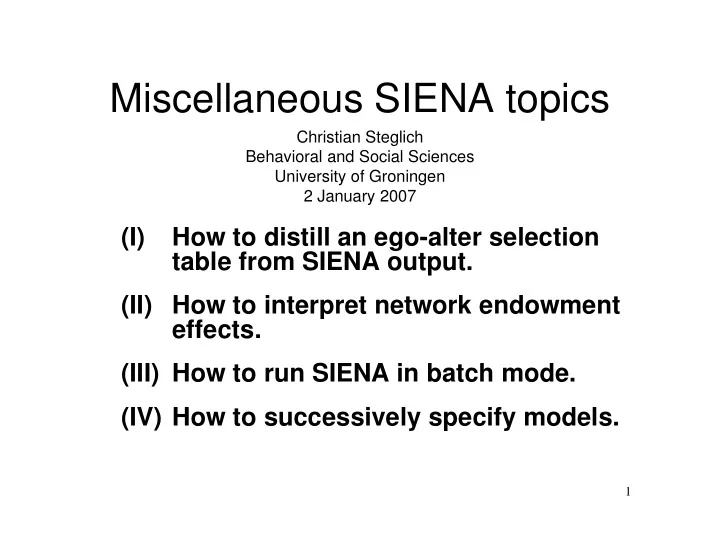

Miscellaneous SIENA topics Christian Steglich Behavioral and Social Sciences University of Groningen 2 January 2007 (I) How to distill an ego-alter selection table from SIENA output. (II) How to interpret network endowment effects. (III) How to run SIENA in batch mode. (IV) How to successively specify models. 1
(I) How to distill an ego-alter selection table from SIENA output. The table (taken from Steglich, Snijders & West, 2006) shows contributions to ego’s objective function for highest / lowest possible scores on the dependent variable ‘alcohol consumption’. alter low low high high low 0.20 -0.75 ego high -0.75 -0.03 It illustrates homophily: non-drinkers prefer non- drinkers as friends, while drinkers prefer drinkers. For non-drinkers, this preference is more pronounced. 2
SIENA output needed: (1) The estimates of the similarity, ego and alter effects in the network objective function: �� ������������������� ������������������� ������������������������������������ ������������������������������ �� ������������������������������ ��������������������� ������!��������"���������������##$%��!������#�&" ��������������������� ������!��������"������������������'��!�����&$%�" ���� ����������������������������������������������������&�#&#%��!���&��%$�" �%����������������������(�!��������"���������������&�'�#��� �%����������������������(�!��������"���������������&�'�#���!���&��$��" �%����������������������(�!��������"���������������&�'�#��� �%����������������������(�!��������"���������������&�'�#��� �$������������������������������������������������� �$������������������������������������������������ �$������������������������������������������������ �$������������������������������������������������ � � �&�&��$�� &�&��$�� &�&��$��!���&�&��'" &�&��$�� �'������������������������������������������������� �'������������������������������������������������ �'������������������������������������������������ �'������������������������������������������������ � � �&�&�'#�� &�&�'#�� &�&�'#��!���&�&���" &�&�'#�� �������)���*������������������(���������������������&�&��%��!���&��#'�" ���� 3
SIENA output needed: (2) The range of the variable: �� ������������������������*����)���� ���������������������������������� ��������������������*����)�����������+,-.���������������� +�/�������/����/012������������� ��������� ��������� #�������������������*����)���������32+.,.2 32+.,.2 ��������������� 32+.,.2 32+.,.2 +�/�������/����/012���������� 4�����&������������������������������ 5�������������6�������������*������������������ 5�������������6�������������*������������������ 5�������������6�������������*������������������ 5�������������6�������������*������������������ 3����������#�����������������*����)���� Note that for actor covariates , the maximum and minimum values have to be taken after centring, and are not reported in the outputfile! Assess them from the data, and subtract the mean value reported in the output file. 4
SIENA output needed: (3) The global average similarity on the variable: ��� 7����������������(�*����)��������������������������������*������8� ��������������)�������� ������������������ 9��������(��������������������&��&#' 9��������(��������������������&�%#'# 9��������(���� ���������������&�$#$� 9��������(���� ���������������&�$#$� 9��������(��������������������&���&� 9��������(��������������������&�%��' 9��������(��������������������&�%��' 9��������(��������������������&�%��' 9��������(��������������������&�%��' ���������)�������������������(�*�������)�������������� )�����������������������������������&�&�#�$'�� ���� 5
How to proceed? (A) Make an ego-alter table: alter low: 1 high: 5 similarity=1 similarity=0 low: 1 ego similarity=0 similarity=1 high: 5 6
How to proceed? (B) Centre similarity values: alter low: 1 high: 5 sim(centrd)=1– 0.6918 sim(centrd)=0– 0.6918 low: 1 = 0.3082 = –0.6918 ego sim(centrd)=0– 0.6918 sim(centrd)=1– 0.6918 high: 5 = –0.6918 = 0.3082 7
How to proceed? (C1) Calculate sum of effects: alter low: 1 high: 5 sim(centrd)= 0.3082 sim(centrd)= –0.6918 low: 1 1 � ego-parameter 1 � ego-parameter 1 � ego-parameter 1 � ego-parameter + 1 � alter-parameter + 5 � alter-parameter ego + 0.3082 � similarity- + –0.6918 � similarity- parameter parameter sim(centrd)= –0.6918 sim(centrd)= 0.3082 high: 5 5 � ego-parameter 5 � ego-parameter + 1 � alter-parameter + 5 � alter-parameter + –0.6918 � similarity- + 0.3082 � similarity- parameter parameter 8
How to proceed? (C2) Calculate sum of effects: alter low: 1 high: 5 1 � –0.0284 1 � –0.0284 low: 1 + 1 � –0.0297 + 5 � –0.0297 + 0.3082 � 0.8341 + –0.6918 � 0.8341 ego = 0.1990 = –0.7539 5 � –0.0284 5 � –0.0284 high: 5 + 1 � –0.0297 + 5 � –0.0297 + –0.6918 � 0.8341 + 0.3082 � 0.8341 = –0.7487 = –0.0334 9
(II) How to interpret network endowment effects. • outdegree = A • reciprocity = B • breaking reciprocated tie = C +A –A Diagrams show changes in the objective function for the purple (upper left) actor that are implied by the transitions indicated by the arrows between dyad states. +A+B –A–B+C 10
Recommend
More recommend